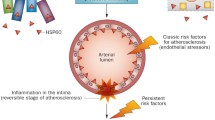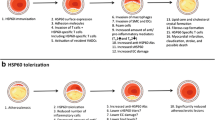Abstract
It has been previously reported that the plasma levels of autoantibodies against heat shock protein 70 (HSP70) are elevated in atherosclerosis. The aim of the present study was to elucidate whether anti-HSP70 antibodies are involved in the pathogenesis of atherosclerosis. To determine this, we chose rats as an atherosclerosis model. Titers of plasma anti-HSP70 autoantibody were determined by ELISA. After the intravenous administration of antibody into the tail, the damaged areas of aorta were stained with Evans Blue, atheromatous plaque were stained by Oil Red O, and then they were measured and quantified with AxioVision computer software. The number of macrophages (\( {{\hbox{M}}_\Phi } \)), smooth muscle cells (SMCs), and T cells were determined by immunocytochemistry. The level of anti-HSP70 IgG1 antibody was apparently increased in the AS group at the tenth week, and one hybridoma of HSP70 antibody (BD091, IgG1, recognizing C-terminal) had the same binding epitope as plasma anti-HSP70 autoantibodies. After intravenous administration, the lesion area of aorta with BD091 was significantly larger than those of IgGmouse and SPA-810. Moreover, injection of BD091 resulted in significant endothelium damage, followed by a greater accumulation of \( {{\hbox{M}}_\Phi } \), T cells, and SMCs in lesions than in the control. In conclusion, BD091 reaction with HSP70 expressed on arterial endothelial cells inducing endothelium damage triggers the inflammatory response in the vessel wall that accelerates atherosclerosis in rats. BD091 shares the same binding epitope with HSP70 autoantibodies. These data indicated that a specific epitope of anti-HSP70 autoantibody participated in the pathogenesis of atherosclerosis.




Similar content being viewed by others
Abbreviations
- SMCs:
-
Smooth muscle cells
- IgG:
-
Immunoglobulin G
- SPA-810:
-
Anti-HSP70 monoclonal antibody (binding site, 437-504)
- mAb:
-
Monoclonal antibody
- \( {{\hbox{M}}_\Phi } \) :
-
Macrophage
- ELISA:
-
Enzyme-linked immunosorbent assay
- BD091:
-
Anti-HSP70 mAb antibody (which recognized HSP70 C-terminal)
- LDH:
-
Lactate dehydrogenase
- PBS:
-
Phosphate-buffered saline
- AS:
-
Atherosclerosis
- HRP:
-
Horseradish peroxidase
- TMB:
-
Tetramethyl benzidine
- OxLDL:
-
Oxidized low-density lipoprotein
- aa:
-
amino acid
References
Amberger A, Maczek C, Jürgens G, Michaelis D, Schett G, Trieb K, Eberl T, Jindal S, Xu Q, Wick G (1997) Co-expression of ICAM-1, VCAM-1, ELAM-1 and Hsp60 in human arterial venous endothelial cells in response to cytokines and oxidized low density lipoproteins. Cell Stress Chaperones 2:94–103
Binder CJ, Chang MK, Shaw PX, Miller YI, Hartvigsen K, Dewan A, Witztum JL (2002) Innate and acquired immunity in atherogenesis. Nat Med 8:1218–1226
Bobryshev YV, Lord RS (2002) Expression of heat shock protein-70 by dendritic cells in the arterial intima and its potential significance in atherogenesis. J Vasc Surg 35:368–375
Botzler C, Li G, Issels RD, Multhoff G (1998) Definition of extracellular localized epitopes of Hsp70 involved in an NK immune response. Cell Stress Chaperones 3:6–11
Buege JA, Aust SD (1978) Microsomal lipid peroxidation. Methods Enzymol 52:302–310
Cai GJ, Miao CY, Xie HH, LH LU, DF SU (2005) Arterial baroreflex dysfunction promotes atherosclerosis in rats. Atherosclerosis 183:41–47
Chan YC, Shukla N, Samee-M A, Berwanger CS, Stanford J, Singh M, Mansfield AO, Stansby G (1999) Anti-heat-shock protein 70 kDa antibodies in vascular patients. Eur J Vasc Endovasc Surg 18:381–385
Figueredo A, Ibarra JL, Rodriguez A, Molino AM, Gomez-de la Concha E, Fernandez-Cruz A, Patiño R (1996) Increased serum levels of IgA antibodies to HSP70 protein in patients with diabetes mellitus: their relationship with vascular complications. Clin Immunol Immunopathol 79:252–255
Hansson GK, Holm J, Jonasson L (1989) Detection of activated T lymphocytes in the human atherosclerotic plaque. Am J Pathol 135:169–175
Hoofnagle MH, Thomas JA, Wamhoff BR, Owens GK (2006) Origin of neointimal smooth muscle: we’ve come full circle. Arterioscler Thromb Vasc Biol 26:2579–2581
Jacob G, Shai G, Iris B, Madhavir S, Sara P-C, Shlomo L, Gad K (2001) Accelerated intimal thickening in carotid arteries of balloon-injured rats after immunization against heat shock protein 70. JACC 38(5):1564–1569
Jonasson L, Holm J, Skalli O, Bondjers G, Hansson GK (1986) Regional accumulations of T cells, macrophages, and smooth muscle cells in the human atherosclerotic plaque. Arteriosclerosis 6:131–138
Jürgens G, Xu QB, Huber LA, Böck G, Howanietz H, Wick G, Traill KN (1989) Promotion of lymphocyte growth by high density lipoproteins (HDL): physiological significance of the HDL binding site. J Biol Chem 264:8549–8556
Kwei S, Stavrakis G, Takahas M, Taylor G, Folkman MJ, Gimbrone MA Jr, García-Cardeña G (2004) Early adaptive responses of the vascular wall during venous arterialization in mice. Am J Pathol 164:81–89
Kreisel D, Krupnick AS, Szeto WY, Popma SH, Sankaran D, Krasinskas AM, Amin KM, Rosengard BR (2001) A simple method for culturing mouse vascular endothelium. J Immunol Methods 254:31–45
Libby P (2002) Inflammation in atherosclerosis. Nature 420:868–874
Lindner V, Fingerle J, Reidy MA (1993) Mouse model of arterial injury. Circ Res 73:792–796
Martin-Ventura JL, Leclercq A, Blanco-Colio LM, Egido J, Rossignol P, Meilhac O, Michel JB (2007) Low plasma levels of HSP70 in patients with carotid atherosclerosis are associated with increased levels of proteolytic markers of neutrophil activation. Atherosclerosis 194:334–341
Mayr M, Metzler B, Kiechl S, Willeit J, Schett G, Xu Q, Wick G (1999) Endothelial cytotoxicity mediated by serum antibodies to heat shock proteins of Escherichia coli and Chlamydia pneumoniae: immune reactions to heat shock proteins as a possible link between infection and atherosclerosis. Circulation 99:1560–1566
Moghadasian MH (2002) Experimental atherosclerosis. A historical overview. Life Sci 70:855–865
Multhoff G, Pfister K, Gehrmann M, Hantschel M, Gross C, Hafner M, Hiddemann W (2001) A 14-mer Hsp70 peptide stimulates natural killer (NK) cell activity. Cell Stress Chaperones 6:337–344
Paigen B, Morrow A, Holmes PA, Mitchell D, Williams RA (1987) Quantitative assessment of atherosclerotic lesions in mice. Atherosclerosis 68:231–240
Pockley AG (2002) Heat shock proteins, inflammation, and cardiovascular disease. Circulation 105:1012–1017
Pockley AG, Georgiades A, Thulin T, de Faire U, Frostegård J (2003) Serum heat shock protein 70 levels predict the development of atherosclerosis in subjects with established hypertension. Hypertension 42:235–238
Rahbarizadeh F, Rasaee MJ, Madani R, Rahbarizadeh MH, Omidfar K (2000) Preparation and characterization of specific and high-affinity monoclonal antibodies against morphine. Hybridoma 19:413–417
Ross R (1999) Atherosclerosis—an inflammatory disease. N Engl J Med 340:115–126
Schett G, Xu Q, Amberger A, Van der Zee R, Recheis H, Willeit J, Wick G (1995) Autoantibodies against heat shock protein 60 mediate endothelial cytotoxicity. J Clin Invest 96:2569–2577
Suzuki K, Murtuza B, Sammut IA, Latif N, Jayakumar J, Smolenski RT, Kaneda Y, Sawa Y, Matsuda H, Yacoub MH (2002) Heat shock protein 72 enhances manganese superoxide dismutase activity during myocardial ischemia–reperfusion injury, associated with mitochondrial protection and apoptosis reduction. Circulation 106(12 Suppl 1):I270–I276
Tanaka S, Kimura Y, Mitani A, Yamamoto G, Nishimura H, Spallek R, Singh M, Noguchi T, Yoshikai Y (1999) Activation of T cells recognizing an epitope of heat-shock protein 70 can protect against rat adjuvant arthritis. J Immunol 163:5560–5565
Wendling U, Paul L, van der Zee R, Prakken B, Singh M, van Eden W (2000) A conserved mycobacterial heat shock protein (hsp) 70 sequence prevents adjuvant arthritis upon nasal administration and induces IL-10-producing T cells that cross-react with the mammalian self-HSP70 homologue. J Immunol 164:2711–2717
Wick G, Knoflach M, Xu Q (2004) Autoimmune and inflammatory mechanisms in atherosclerosis. Ann Rev Immunol 22:361–403
Williams RS, Benjamin IJ (2000) Protective responses in the ischemic myocardium. J Clin Invest 106:813–818
Wu T, Tanguay RM (2006) Antibodies against heat shock proteins in environmental stresses and diseases: friend or foe? Cell Stress Chaperones 11:1–12
Wu T, Yuan Y, Wu Y, He H, Zhang G, Tanguay RM (1998) Presence of antibodies to heat stress proteins in workers exposed to benzene and in patients with benzene poisoning. Cell Stress Chaperones 3:161–167
Xu Q (2002) Role of heat shock proteins in atherosclerosis. Arterioscler Thromb Vasc Biol 22:1547–1559
Xu Q, Jürgens G, Huber LA, Böck G, Wolf H, Wick G (1992) Lipid utilization by human lymphocytes is correlated with high-density-lipoprotein binding site activity. Biochem J 285:105–112
Xu Q, Kiechl S, Mayr M, Metzler B, Egger G, Oberhollenzer F, Willeit J, Wick G (1999) Association of serum antibodies to heat shock protein 65 with carotid atherosclerosis: clinical significance determined in a follow-up study. Circulation 100:1169–1174
Yamashita N, Hoshida S, Nishida M, Igarashi J, Aoki K, Hori M, Kuzuya T, Tada M (1997) Time course of tolerance to ischemia-reperfusion injury and induction of heat shock protein 72 by heat stress in the rat heart. J Mol Cell Cardiol 29:1815–1821
Zhu J, Quyyumi AA, Wu H, Csako G, Rott D, Zalles-Ganley A, Ogunmakinwa J, Halcox J, Epstein SE (2003) Increased serum levels of heat shock protein 70 are associated with low risk of coronary artery disease. Arterioscler Thromb Vasc Biol 23:1055–1059
Acknowledgements
This research was supported by the Key program of the Chinese National Natural Science Foundation (grant no. 30430590) and Tianjin Basic Research Program of Applied (grant no. 07JCYBJC08900).
Author information
Authors and Affiliations
Corresponding author
Rights and permissions
About this article
Cite this article
Leng, X., Zhan, R., Wang, Y. et al. Anti-heat shock protein 70 autoantibody epitope changes and BD091 promotes atherosclerosis in rats. Cell Stress and Chaperones 15, 947–958 (2010). https://doi.org/10.1007/s12192-010-0203-0
Received:
Revised:
Accepted:
Published:
Issue Date:
DOI: https://doi.org/10.1007/s12192-010-0203-0




